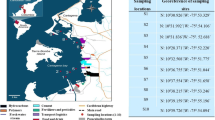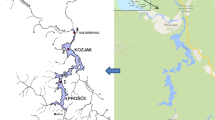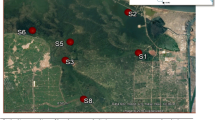Abstract
The aim of this study was to evaluate sediments of the Dniester River, in the former Soviet republic of Moldova, for the occurrence of agricultural pesticides, polychlorinated biphenyls (PCBs), and heavy metals. In October 2001, sediment samples were collected at three locations of the Dniester River: upstream, downstream, and at the tributary of the River Byk. DDT and its metabolites were observed most frequently. Total DDT sediment concentrations ranged from 8.2 to 34.7 ng/g dry weight with the highest average concentration detected at the tributary location. Heptachlor epoxide (< 0.2–3.0 ng/g dry weight), chlordane (< 0.1–6.1 ng/g dry weight), endrin (< 0.2–2.5 ng/g dry weight), phosalone (< 0.2–1.1 ng/g dry weight), and methylparathion (< 0.2–16.8 ng/g dry weight) were also detected. Total PCB concentrations observed in sediments ranged from 68 to 763 ng/g dry wt. Total average PCB concentrations were significantly (p ≤ 0.004) higher for sediments from the downstream sampling sites compared to the upstream samples. Tetra- and trichlorobiphenyls accounted for 84 and 88% of the total residues measured in the downstream and tributary locations, respectively. In contrast, heptachlorobiphenyls were the prevailing homologues in sediments from the upstream sampling site, contributing 51% of the total PCB concentration. Predominant PCB homologues were: trichlorobiphenyl congener 28 and 37, tetrachlorobiphenyl congeners 44, 49, 52, 74, 77, and 81, and heptachlorobiphenyl congener 170. Sediment concentrations of ΣDDE (19.7 ng/g dry weight) in the tributary, heptachlor epoxide (3.0 ng/g dry weight) in the downstream, and nickel (128–170 μg/g dry weight) in all locations exceeded Probable Effect Levels (PELs) established for sediment quality in fresh water, indicating probable environmental stress and the potential for adverse effects to benthic organisms in the Dniester River.










Similar content being viewed by others
References
Agency for Toxic Substances and Disease Registry (ATSDR) (1996) Toxicological Profile for endrin. U.S. Department of Health and Human Services, Public Health Service, Atlanta, GA
Agency for Toxic Substances and Disease Registry (ATSDR) (1993) Toxicological Profile for heptachlor and heptachlor epoxide. U.S. Department of Health and Human Services, Public Health Service, Atlanta, GA
Balthis WL, Hyland JL, Scott GI, Fulton MH, Bearden DW, Greene MD (2002) Sediment quality of the Neuse River estuary, North Carolina: an integrated assessment of sediment contamination, toxicity, and condition of benthic fauna. J Aquat Ecosyst Stress Recov 9:213–225
Boiko T, Kosmus V, Rud’ko G (1999) Heavy metal associations in shore sediments of the Dniester River. Geol Geokhim Gonyuch Kopalin (Geol Geochen Combust Minerals) 4:166–184 (in Ukrainian)
Camusso M, Balestrini R, Martinotti W, Arpin M (1999) Spatial variations in trace metal and stable isotope content of autochthonous organisms and sediments in the river Po system (Italy). Aquat Ecosyst Health Manage 2:39–53
Clements WH, (1991) Community responses of stream organisms to heavy metals: A review of descriptive and experimental approaches. In: New Man MC, McIntosh AW, (eds) Ecotoxicology of metals: Current concepts and applications. CRC Press, Boca Raton, FL, pp 363–391
Cousteau E (1993) Concentration of chemical pollutants in sediments and mussels along the Danube. In: The Danube... for whom and for what? European Bank for Reconstruction and Development Agreement, Final Report, Paris, pp 104–126
De Mora S, Villeneuve J-P, Reza SM, Cattini C, Tolosa I (2004) Organochlorinated compounds in Caspian Sea sediments. Marine Pollut Bull 48:30–43
Fillmann G, Readman JW, Tolosa I, Bartocci J, Villeneuve J-P, Cattini C, Mee LD, (2002) Persistent organochlorine residues in sediments from the Black Sea. Marine Pollut Bull 44:122–133
Galindo-Reyes JG, Fossato VU, Villagrana-Lizarraga C, Dolci F, (1999) Pesticides in water, sediments, and shrimp from a coastal lagoon off the Gulf of California. Marine Pollut Bull 38:837–841
Gallo MA, Lawryk NJ (1991) Organic phosphorus pesticides. In: Hayes WJ Jr, Laws ER Jr (eds) Handbook of pesticide toxicology. Academic Press, Vol. 2 San Diego, California, pp 917–1123
Gan I.M (1990) Ecosystem of Low Dniester under increased anthropogenic influence. Shteenza, Chisinao, 259pp (in Russian)
Howard PH (1991) Handbook of environmental fate and exposure data for organic chemicals, Vol. 3: Pesticides. Lewis Publishers, Chelsea, MI, pp 5–13
Hyland JL, Balthis WL, Hackney CT, Posey M, (2000) Sediment quality of North Carolina estuaries: an integrative assessment of sediment contamination, toxicity, and condition of benthic fauna. J Aquat Ecosyst Stress Recov 8:107–124
Johnson WW, Finley MT, (1980) Handbook of acute toxicity of chemicals to fish and aquatic invertebrates, Resource Publication 137. U.S. Department of Interior, Fish and Wildlife Service, Washington, DC
La Point TW, Melancan SM, Morris MI (1984) Relationships among observed metal concentrations, criteria, and benthic community structural responses in 15 streams. J Water Pollut Control Fed 56:1030–1038
MacDonald DD, Ingersoll GG, Berger TA, (2000) Development and evaluation of consensus-based sediment quality guidelines for freshwater ecosystems. Arch Environ Contam Toxicol 39:20–31
Metcalfe TL, Metcalfe CD (1997) The trophodynamics of PCBs, including mono- and non-ortho congeners, in the food web of North-Central Lake Ontario. Sci Total Environ 201:245–272
Safe SH, (1994) Polychlorinated biphenyls (PCBs): Environmental impact, biochemical and toxic responses, and implications for risk assessment. Crit Rev Toxicol 24:87–149
Semenov AD (ed) (1977) Manual on the chemical analysis of terrestrial surface surface waters. Gidrometeoizdat, Leningrad, p217 (in Russian)
Sirenko LA, Evtushenko NYu, Komarovskyi FYa (1992) Hydrobiological regime of Dniester and its waterbodies. Naukova Dumka, Kiev, 356 pp (in Russian)
Thomson WT, (1992) Agricultural chemicals. Book 1: Insecticides. Thomson Publications, Fresno, CA
U.S. Environmental Protection Agency (US EPA) (1989) Environmental fate and effects division, pesticide environmental fate one line summary: DDT (p,p’). Washington, DC, EPA
Van den Berg M, Birnbaum L, Bosveld ATC, Brunstrom B, Cook P, (1998) Toxic equivalency factors (TEFs) for PCBs, PCDDs, PCDFs for humans and wildlife. Environmen Health Perspect 106:775–792
Viskovatov YuI, Gronik ON, Diskalenko AP (1972) Hygienic significance of the pesticide content of Dniester water at water-intake points. USSR. Vliyanie Yadokhim. Vnesh. Sredu (Effects Toxic Chem Environ) 45:6–10. (in Russian) From: Ref. Zh., Khim. 1973, Abstr. No. 3I205. (in Russian)
Wauchope RD, Buttler TM, Hornsby AG, Augustijn-Beckers PWM, Burt JP (1992) SCS/ARS/CES Pesticide properties database for environmental decision-making. Rev Environ Contam Toxicol 123:1–55
Zolotov Yu A, Kuz’min NM, (1982) Concentration of trace elements (Kontsentrirovanie Mikroelementov), 2nd ed. Khimiya, Moscow (in Russian)
Acknowledgments
The authors would like to thank Civil Research and Development Foundation (CRDF) for providing funding for this study (MBI-3002).
Author information
Authors and Affiliations
Corresponding author
Rights and permissions
About this article
Cite this article
Sapozhnikova, Y., Zubcov, E., Zubcov, N. et al. Occurrence of Pesticides, Polychlorinated Biphenyls (PCBs), and Heavy Metals in Sediments From the Dniester River, Moldova. Arch Environ Contam Toxicol 49, 439–448 (2005). https://doi.org/10.1007/s00244-005-8011-8
Received:
Accepted:
Published:
Issue Date:
DOI: https://doi.org/10.1007/s00244-005-8011-8




